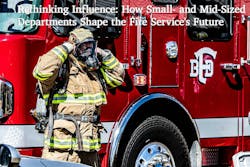Rethinking Influence: How Small and Mid-Sized Departments Shape the Fire Service’s Future
Key Takeaways
- Lean structures and close community connections make small fire departments ideal testing grounds for adaptable, cost-effective strategies that can be scaled up by larger agencies.
- Contrary to the popular belief that metropolitan departments set the direction of the fire service, many innovations originated in smaller departments facing real-time operational challenges with limited resources.
- Standardized policies that reflect urban realities can be ill-suited in communiities where smaller department provide fire protection.
A prevailing narrative in the fire service suggests that metropolitan departments largely determine the direction of the firefighting profession. These agencies often receive the lion's share of attention, funding, and visibility, leading to the assumption that they are the primary architects of fire service progress.
However, a substantial counter argument could challenge this metro-centric view: The fire service's evolution and effectiveness are shaped as much—if not more—by the innovations, adaptability, and practical realities of small- and mid-sized departments as they are by metropolitan agencies. Through the unique lens of having worked at both a large metro agency and a much smaller city department, my view differs from the traditional narrative.
According to the U.S. Fire Administration (USFA, 2023) and the National Fire Protection Association (NFPA, 2021), more than 80% of U.S. fire departments protect communities of fewer than 25,000 people. Approximately 65% of these departments are staffed entirely or primarily by volunteers (Haynes & Stein, 2020). These statistics shatter the myth that metropolitan departments dominate the fire service landscape.
Instead, they point to a decentralized, diverse profession where the operational heartbeat is found in smaller jurisdictions These departments may lack the financial and political clout of their metro counterparts, but they thrive on operational creativity and resilience. In communities with limited tax bases and geographic isolation, fire departments must develop adaptive strategies to meet their missions. These constraints often catalyze pragmatic and practical innovations, particularly in addressing fireground safety, staffing models, and community engagement (Haddock et al., 2022).
Small- and mid-sized fire departments find themselves uniquely positioned to test scalable models of service delivery and innovation. Their leaner structures allow for faster decision-making and closer engagement between leadership and frontline personnel. These agencies often serve as incubators for low-cost solutions that can later be scaled up on a larger level.
For example, community risk reduction (CRR) efforts, including smoke detector installation programs, home safety visits, and senior citizen fall-prevention campaigns, were initially implemented by small volunteer departments working to reduce preventable incidents within their limited response capacity (Firefighter Life Safety Initiatives, 2023). Over time, these same approaches were formalized and expanded by metro departments once proven effective and manageable.
Similarly, in the wildland-urban interface (WUI), smaller fire departments have faced firsthand the convergence of structural firefighting and the wildland firefighting arena. Departments in the American West, for instance, have had to pioneer hybrid suppression models that integrate municipal water delivery, wildland tactics, and evacuation coordination (Cova et al., 2017). These models are now being studied and adopted by larger urban departments confronting growing WUI threats due to suburban sprawl.
In yet another example, smaller organizations have demonstrated leadership in EMS integration. In many rural jurisdictions, the fire department is the only entity capable of delivering emergency medical care. This necessity has driven a culture of cross-certification, dual-role staffing, and innovation in non-transport EMS programs—developments that are now informing urban mobile integrated healthcare initiatives (IAFC, 2020).
The hazards, risks, and expectations facing fire departments vary significantly across different geographical areas, populations, and resource availability. What works in a vertical high-rise environment in downtown Chicago may have no relevance in a wildland-agriculture interface in Montana or a coastal, hurricane-prone town in Florida. Yet, national-level discourse and policy development often focus disproportionately on the needs of large urban centers.
This misalignment can be problematic. Standardized models developed in cities may prove impractical or even dangerous in non-metro settings. As McEntire (2015) points out, effective emergency response must reflect local risk profiles and operational realities. For instance, rural firefighters may require different training emphases—such as water shuttle operations or wildland line construction—than their urban counterparts, who are often focused on engine and truck company operations with an abundance of staffing.
When metro needs overly shape fire service policy, it risks marginalizing the very departments that represent the majority. A truly inclusive and effective fire service must engage these smaller agencies not only as implementers but as co-creators of policy and strategy.
History has repeatedly shown that innovation and leadership in the fire service often arise from the bottom up. Small departments, faced with immediate operational challenges and minimal resources, often generate the most creative and practical solutions. Over time, these solutions gain traction nationally. Take, for instance, the early adoption of residential sprinkler advocacy, juvenile fire-setter intervention programs, and community paramedicine initiatives—each of which had roots in small departments seeking local solutions to local problems (Donahue & Tuohy, 2006). These grassroots models were later studied, adapted, and expanded by metro departments and eventually endorsed by national organizations.
The belief that cutting edge leadership and innovation comes only from metro departments is not only inaccurate—it's detrimental. Influential fire service leaders, policy contributors, and instructors come from communities of all sizes. Organizations such as the International Association of Fire Chiefs (IAFC), the National Fire Protection Association (NFPA), and the National Fallen Firefighters Foundation (NFFF) recognize this and intentionally cultivate leadership development across various department sizes (IAFC, 2020; NFPA, 2023).
As I have seen firsthand, many current national leaders began their careers in small departments and carry those experiences into their expanded agency roles. This lived understanding of rural, combination, or volunteer department challenges and enriches national policy discussions, curriculum development, and funding advocacy. It ensures that the fire service remains representative, equitable, and responsive to the full range of its practitioners. Metro departments undeniably bring valuable expertise, resources, and visibility to the fire service. But they do not—and should not—define the profession's trajectory alone. The fire service's direction is a collaborative, multi-layered process shaped by the collective efforts of departments large and small.
Small and mid-sized agencies are not merely followers—they are leaders in innovation, adaptability, and service delivery. They develop practical solutions, test scalable programs, and maintain the human-centered focus that is the cornerstone of the profession. Recognizing and elevating their contributions ensures the fire service remains resilient, relevant, and responsive to all communities—urban, suburban, and rural alike. As the landscape of hazards continues to evolve, so too must the recognition that leadership and influence emerge from every corner of the American fire service.
References
- Cova, T. J., Dennison, P. E., & Kim, T. H. (2017). Setting wildfire evacuation trigger points using fire spread modeling and GIS. Fire Safety Journal, 91, 32–40.
- Donahue, A. K., & Tuohy, R. V. (2006). Lessons we don't learn: A study of the lessons of disasters, why we repeat them, and how we can learn them. Homeland Security Affairs, 2(2).
- Firefighter Life Safety Initiatives. (2023). Everyone Goes Home Program. National Fallen Firefighters Foundation.
- Haddock, C. K., Jahnke, S. A., & Poston, W. S. C. (2022). Innovative practices among rural fire departments: Operational adaptability under constraint. American Journal of Public Health, 112(4), 518–524.
- Haynes, H. J. G., & Stein, G. P. (2020). U.S. Fire Department Profile. National Fire Protection Association.
- International Association of Fire Chiefs (IAFC). (2020). Community Risk Reduction: A Policy Primer for the Fire Service.
- McEntire, D. A. (2015). Disaster response and recovery: Strategies and tactics for resilience. Wiley.
- National Fire Protection Association (NFPA). (2021). Fourth Needs Assessment of the U.S. Fire Service.
- U.S. Fire Administration (USFA). (2023). Fire Department Statistics and Demographics. U.S. Department of Homeland Security.
About the Author

Kristopher Blume
Kristopher T. Blume is the fire chief of the Meridian, ID, Fire Department and has more than two decades of fire service experience. He is an author, lecturer and independent consultant. Blume is a graduate of the Executive Fire Officer (EFO) program and is an instructor at the National Fire Academy. As a student of the fire service, he is focused on values-driven, mission-focused leadership for the profession. He is the author of "Carry the Fire: The Crucible of Leadership in the Fire Service".
